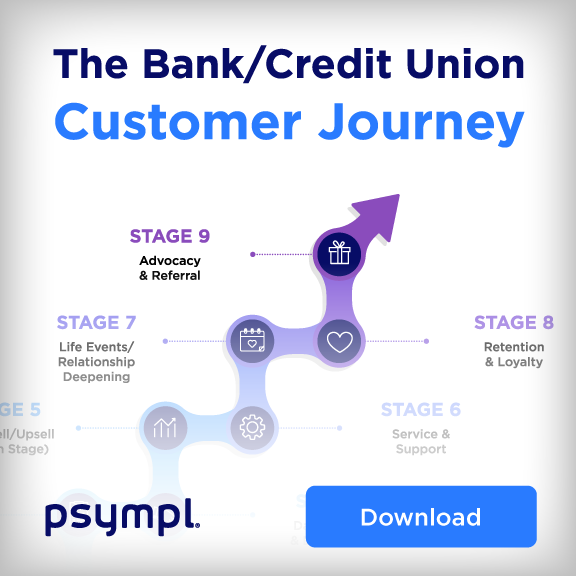Banks collect massive amounts of customer data yet still struggle to create meaningful connections with their clients. Traditional demographic information like age and income reveals who customers are, while transaction history shows what they do, but neither explains why they make financial decisions.

Psychographic data in banking goes beyond surface-level demographics to uncover customers' values, attitudes, motivations, and lifestyle preferences, enabling financial institutions to create deeply personalized experiences that resonate with individual psychological profiles. This approach transforms how banks understand their customers by revealing the emotional and psychological drivers behind financial behaviors.
The shift toward psychographic segmentation in banking represents a fundamental change in customer experience strategy. Financial institutions that master this approach can anticipate customer needs, reduce churn, and build stronger relationships by addressing the underlying motivations that influence everything from product preferences to communication channel choices.
The Limits of Demographic and Behavioral Data

Traditional demographic segmentation categorizes customers by age, income, gender, and location. Banks currently rely heavily on this quantitative data to understand customer needs, but these metrics provide only surface-level insights.
Demographic data tells financial institutions who their customers are but fails to explain why they make specific financial decisions. Two customers with identical demographics may have vastly different attitudes toward risk and investment preferences.
A 35-year-old professional earning $100,000 could be either a conservative saver focused on security or an aggressive investor seeking growth opportunities. Age and income alone cannot predict these fundamental differences in financial behavior.
Conventional segmentation techniques frequently depend on static demographic data, which may offer an antiquated and constrained understanding of consumer requirements. This approach leads to generic marketing messages that fail to resonate with diverse customer motivations.
Behavioral data limitations include:
- Transaction patterns without context about underlying motivations
- Usage frequency that doesn't reveal preference drivers
- Channel preferences that miss emotional triggers
- Product history that lacks insight into future needs
Demographic data gives a surface-level view, but fails to capture the motivations, beliefs, and attitudes that drive consumer behavior. Financial institutions need deeper insights to create meaningful customer connections and develop relevant products.
Banks that rely solely on demographic and behavioral segmentation miss critical opportunities for personalization and targeted marketing effectiveness.
What Is Psychographic Data — And Why It Matters in Banking

Psychographic data refers to qualitative attributes that capture consumer personalities, values, attitudes, and lifestyle preferences. Unlike demographic data that shows age and income, psychographic insights reveal the motivations behind financial decisions.
Banks traditionally rely on quantitative metrics like account balances and transaction history. Psychographic segmentation reveals why customers make financial decisions rather than simply who they are.
Key psychographic elements include:
- Personal values and beliefs
- Lifestyle preferences
- Spending motivations
- Risk tolerance attitudes
- Financial goals and priorities
Banks must get savvy with customer segmentation to remain competitive. Traditional age-based targeting proves ineffective for modern banking needs.
Financial institutions can use psychographic data to identify customers who prefer digital banking over branch visits. A bank scouting locations might use psychographics to avoid overinvesting in neighborhoods where people prefer online banking.
This data enables banks to create targeted product offerings and personalized communication strategies. Understanding human behavior, desires, and values allows institutions to anticipate customer needs and build stronger relationships.
The integration of demographic and psychographic data creates comprehensive customer profiles. This approach helps banks identify cross-selling opportunities and develop products that align with customer lifestyles and values.
How Psychographic Data Elevates CX in Financial Services
Psychographic segmentation enables financial institutions to identify customer motivations, behaviors, and preferences for more precise targeting and engagement. This approach moves beyond traditional demographic analysis to understand the psychological drivers behind financial decisions.
Financial institutions typically rely on quantitative metrics like income and asset size. However, psychographic data reveals values, lifestyle, interests, and financial attitudes that provide deeper insights into customer motivations and preferences.
Key Benefits of Psychographic CX Enhancement:
- Personalized messaging that resonates with individual customer values
- Targeted product recommendations based on risk tolerance and financial goals
- Improved client engagement through understanding decision-making patterns
- Enhanced retention rates via meaningful customer interactions
Banks can match product offerings to customer comfort levels with financial uncertainty. Research by Psympl demonstrates that understanding psychological drivers allows for more personalized and resonant financial advice.
The technology enables wealth managers to create more targeted marketing campaigns. When customers experience better banking interactions, their intentions to stay with the brand, purchase additional services, and recommend the institution all increase significantly.
Psychographic insights help financial advisors understand why clients make specific choices rather than just what those choices are. This deeper understanding facilitates more meaningful conversations and builds stronger advisor-client relationships.
Turning Insights Into Action — Making CX Personal at Scale
Data-driven marketing has become essential for brands seeking meaningful customer connections. Organizations collect vast amounts of psychographic data but struggle to transform these insights into actionable customer experiences.
The key challenge lies in bridging the insight-to-action gap that prevents meaningful change. Companies often have rich psychographic profiles but lack systematic approaches to operationalize this knowledge.
Critical Action Steps:
- Segment by Values: Group customers based on shared beliefs and motivations rather than demographics alone
- Automate Personalization: Use psychographic triggers to customize messaging across touchpoints
- Test Continuously: Deploy A/B tests using different value-based appeals to refine approaches
Successful implementation requires integrating insights into workflows rather than keeping data isolated in reports. Teams need accessible dashboards that translate complex psychographic patterns into clear customer personas.
Scale becomes achievable when organizations establish automated decision trees. These systems match customer psychographic profiles to appropriate content, offers, and communication styles without manual intervention.
|
Psychographic Trigger |
Automated Response |
Expected Outcome |
|
Security-focused values |
Risk-mitigation messaging |
Higher trust scores |
|
Adventure-seeking traits |
Experience-based offers |
Increased engagement |
|
Community orientation |
Social proof emphasis |
Better conversion rates |
CX analytics platforms now enable real-time personalization at enterprise scale. Companies can deliver individualized experiences while maintaining operational efficiency across millions of customer interactions.
Steps to Start Using Psychographic Data in Banking
Banks need a systematic approach to implement psychographic segmentation strategies. The process requires careful planning and execution across multiple phases.
Step 1: Define Clear Objectives
Financial institutions must establish specific goals before collecting data. Common objectives include improving customer engagement, developing targeted products, or enhancing marketing campaign effectiveness.
Step 2: Gather Comprehensive Data
Banks should collect psychographic data through multiple channels. Essential collection methods include:
- Customer surveys about values and lifestyle preferences
- In-depth interviews exploring financial attitudes
- Social media analysis of customer interactions
- Website behavior tracking and analytics
- Customer feedback from various touchpoints
Step 3: Analyze and Identify Patterns
Data analysts examine collected information to find common themes. Cluster analysis tools help group customers based on shared psychological characteristics and financial behaviors.
Step 4: Integrate with Existing Data
Banks must combine psychographic insights with demographic and behavioral data to create complete customer profiles. This integration provides deeper understanding than traditional segmentation methods alone.
Step 5: Create Detailed Customer Personas
Financial institutions develop specific personas representing each psychographic segment. These personas include psychological profiles, financial attitudes, and preferred communication channels.
Step 6: Implement Targeted Strategies
Banks tailor their products, services, and marketing messages to match each persona's characteristics. This personalized approach improves customer satisfaction and engagement rates.
Step 7: Monitor and Refine
Regular performance monitoring ensures segmentation remains effective. Banks adjust their strategies based on customer feedback and changing market conditions.
As one might surmise from the steps outlined above, developing and operationalizing psychographics is resource and time intensive. A good psychographic model developed from scratch can cost six figures, and 50% of psychographic models fail at producing actionable insights.
The great news is Psympl has partnered with Ipsos, the world-class market research firm, to develop a highly predictive financial psychographic model for banks, credit unions, wealth management firms and financial services companies. Moreover, Psympl offers extensive financial psychographic insights from its market research and psychographic segment heatmapping capabilities for customer prospecting.
Critical for operationalizing psychographics, Psympl’s PsymplifierTM uses Psychographic AITM to generate segment-specific content for marketing, education, and interpersonal engagement, including emails, social media, call scripts, long form content, text messaging, and other channels.
These products integrate with, and enhance, existing CRMs and customer engagement platforms to maximize these current technology investments.
The Future of CX Belongs to Empathy and Intent
Customer experience leaders are building autonomous systems that operate with human-centric design principles, while predictive analytics enables organizations to anticipate customer needs before they surface. The convergence of emotional intelligence with AI-driven personalization creates experiences that feel both intuitive and deeply personal.
See Beyond Data — Build Emotionally Intelligent CX
Psychographic data banking enables organizations to move beyond reactive customer service toward proactive CX that anticipates customer needs through AI and predictive analytics. Companies can identify behavioral patterns and emotional triggers before customers explicitly express them.
The integration of AI and human empathy continues shaping customer experience strategies as businesses recognize that technology alone cannot build lasting relationships. Psychographic insights allow AI systems to deliver contextually appropriate responses that match individual personality types and communication preferences.
Empathetic automation becomes possible when psychographic profiles inform AI decision-making processes. Systems can adjust tone, timing, and interaction methods based on customer psychological profiles rather than demographic data alone.
CX leaders who prioritize empathy foster stronger relationships and drive customer satisfaction by understanding the emotional motivations behind customer actions. Psychographic banking provides the foundation for this understanding at scale.
The future belongs to organizations that combine predictive capabilities with emotional intelligence. These companies will create experiences that feel personally crafted for each individual's psychological makeup and behavioral tendencies.
Ready to elevate your CX strategy?
Discover how psychographic data in banking helps you understand client motivations and deliver experiences that truly connect.

Brent Walker
Co-Founder & Chief Strategy Officer






.svg)
